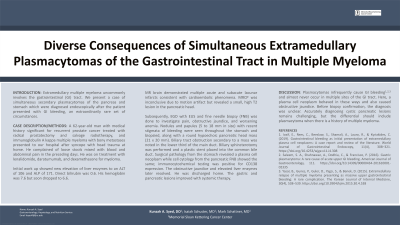Monday Poster Session
Category: GI Bleeding
P2064 - Diverse Consequences of Simultaneous Extramedullary Plasmacytomas of the Gastrointestinal Tract in Multiple Myeloma
Monday, October 23, 2023
10:30 AM - 4:15 PM PT
Location: Exhibit Hall

Has Audio
- KS
Kunzah A. Syed, DO
Johns Hopkins Hospital
Baltimore, MD
Presenting Author(s)
Award: Presidential Poster Award
Kunzah A. Syed, DO1, Isaiah Schuster, MD2, Mark Schattner, MD3
1Johns Hopkins Hospital, New York, NY; 2St. Francis Hospital, Roslyn, NY; 3Memorial Sloan Kettering Cancer Center, New York, NY
Introduction: Extramedullary multiple myeloma uncommonly involves the gastrointestinal (GI) tract. We present a case of simultaneous secondary plasmacytomas of the pancreas and stomach which were diagnosed endoscopically after the patient presented with GI bleeding, an extraordinarily rare set of circumstances.
Case Description/Methods: A 62-year-old man with medical history significant for recurrent prostate cancer treated with radical prostatectomy and salvage radiotherapy, and immunoglobulin A kappa multiple myeloma with bony metastases presented to our hospital after syncope with head trauma at home. He complained of loose stools mixed with blood and abdominal pain in the preceding days. He was on treatment with lenalidomide, daratumumab, and dexamethasone for myeloma. Initial work up showed new elevation of liver enzymes to an ALT of 106 and ALP of 171. Direct bilirubin was 0.6. His hemoglobin was 7.6 but soon dropped to 6.6. MR brain demonstrated multiple acute and subacute lacunar infarcts consistent with cardioembolic phenomena. Right upper quadrant ultrasound showed a 1.4 x 1.3 x 1.7 cm hypoechoic pancreatic lesion with communication to the duct, thought to be a branch duct intraductal papillary mucinous neoplasm (IPMN). MRCP was inconclusive due to motion artifact but revealed a small high T2 lesion in the pancreatic head. Subsequently, EGD with EUS and fine needle biopsy (FNB) was done to investigate pain, worsening anemia, and obstructive jaundice. Nodules and papules (5 to 18 mm) with recent stigmata of bleeding were seen throughout the stomach and biopsied, along with a round, hypoechoic pancreatic head mass (21 x 20 mm). Biliary tract obstruction secondary to a mass was found in the lower third of the main duct. Biliary sphincterotomy was performed and a plastic stent placed into the common bile duct. Surgical pathology from the stomach revealed a plasma cell neoplasm while cell cytology from the pancreatic FNB showed the same; immunocytochemical testing was positive for CD138 expression. Patient’s obstructive jaundice and elevated liver enzymes resolved. He was later discharged home.
Discussion: Plasmacytomas infrequently cause GI bleeding and almost never occur in multiple sites of the GI tract. Here, a plasma cell neoplasm also caused obstructive jaundice and was thought to be an IPMN before biopsy results returned. Accurately diagnosing cystic pancreatic lesions remains challenging, but the differential should include plasmacytoma when there is a history of multiple myeloma.
Disclosures:
Kunzah A. Syed, DO1, Isaiah Schuster, MD2, Mark Schattner, MD3. P2064 - Diverse Consequences of Simultaneous Extramedullary Plasmacytomas of the Gastrointestinal Tract in Multiple Myeloma, ACG 2023 Annual Scientific Meeting Abstracts. Vancouver, BC, Canada: American College of Gastroenterology.
Kunzah A. Syed, DO1, Isaiah Schuster, MD2, Mark Schattner, MD3
1Johns Hopkins Hospital, New York, NY; 2St. Francis Hospital, Roslyn, NY; 3Memorial Sloan Kettering Cancer Center, New York, NY
Introduction: Extramedullary multiple myeloma uncommonly involves the gastrointestinal (GI) tract. We present a case of simultaneous secondary plasmacytomas of the pancreas and stomach which were diagnosed endoscopically after the patient presented with GI bleeding, an extraordinarily rare set of circumstances.
Case Description/Methods: A 62-year-old man with medical history significant for recurrent prostate cancer treated with radical prostatectomy and salvage radiotherapy, and immunoglobulin A kappa multiple myeloma with bony metastases presented to our hospital after syncope with head trauma at home. He complained of loose stools mixed with blood and abdominal pain in the preceding days. He was on treatment with lenalidomide, daratumumab, and dexamethasone for myeloma. Initial work up showed new elevation of liver enzymes to an ALT of 106 and ALP of 171. Direct bilirubin was 0.6. His hemoglobin was 7.6 but soon dropped to 6.6. MR brain demonstrated multiple acute and subacute lacunar infarcts consistent with cardioembolic phenomena. Right upper quadrant ultrasound showed a 1.4 x 1.3 x 1.7 cm hypoechoic pancreatic lesion with communication to the duct, thought to be a branch duct intraductal papillary mucinous neoplasm (IPMN). MRCP was inconclusive due to motion artifact but revealed a small high T2 lesion in the pancreatic head. Subsequently, EGD with EUS and fine needle biopsy (FNB) was done to investigate pain, worsening anemia, and obstructive jaundice. Nodules and papules (5 to 18 mm) with recent stigmata of bleeding were seen throughout the stomach and biopsied, along with a round, hypoechoic pancreatic head mass (21 x 20 mm). Biliary tract obstruction secondary to a mass was found in the lower third of the main duct. Biliary sphincterotomy was performed and a plastic stent placed into the common bile duct. Surgical pathology from the stomach revealed a plasma cell neoplasm while cell cytology from the pancreatic FNB showed the same; immunocytochemical testing was positive for CD138 expression. Patient’s obstructive jaundice and elevated liver enzymes resolved. He was later discharged home.
Discussion: Plasmacytomas infrequently cause GI bleeding and almost never occur in multiple sites of the GI tract. Here, a plasma cell neoplasm also caused obstructive jaundice and was thought to be an IPMN before biopsy results returned. Accurately diagnosing cystic pancreatic lesions remains challenging, but the differential should include plasmacytoma when there is a history of multiple myeloma.
Disclosures:
Kunzah Syed indicated no relevant financial relationships.
Isaiah Schuster indicated no relevant financial relationships.
Mark Schattner: Boston Scientific – Consultant. Mirai Medical – Consultant. Novo Nordisk – Consultant.
Kunzah A. Syed, DO1, Isaiah Schuster, MD2, Mark Schattner, MD3. P2064 - Diverse Consequences of Simultaneous Extramedullary Plasmacytomas of the Gastrointestinal Tract in Multiple Myeloma, ACG 2023 Annual Scientific Meeting Abstracts. Vancouver, BC, Canada: American College of Gastroenterology.

